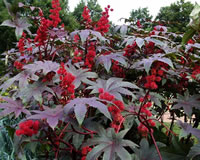Ricin is a naturally occurring substance
in the castor bean plant. It is made from waste left over
after processing
the beans in the production of castor oil, which is used mainly
in industry and
medicines. Obtaining ricin is a simple process of extraction
after the castor oil has been removed. Ricin is a highly toxic
poison, but
has limited value as a harmful biological agent.
Harmful biological agents are
generally divided into either infectious agents or non-infectious
agents. Infectious
agents are:
- pathogenic bacteria
- viruses
- funguses, such as anthrax or smallpox.
|
 |
Non-infectious
agents are called "toxins" and
are produced from:
- infectious agents
- other living organisms and plants
|
Ricin is a toxin produced by the castor bean plant.
Compared to
infectious biological agents such as smallpox, ricin’s
usefulness as a weapon is limited . Not only is a large amount
of ricin necessary to produce the desired effect, it does not convert
easily to an aerosol form, and it does not grow and spread. It is
not contagious.
Ricin Fact Sheet Emergency
Preparedness & Response, Centers for Disease Control and
Prevention
http://www.bt.cdc.gov/agent/ricin/facts.asp
Also available in Spanish and with a downlodable PDF version for
printing.
What
is Ricin? Marshall Brain
http://science.howstuffworks.com/question722.htm
Cornell
Plant Database Ricinus communis (Castor bean)
http://www.ansci.cornell.edu/plants/castorbean.html
Scientists
Play Down Ricin's Lethal Threat Guy Gugliotta, Washington
Post, Page A07, Feb 4, 2004.
http://www.washingtonpost.com/wp-dyn/articles/A10287-2004Feb3.html
Ricin
Toxin from Castor Bean Plant Cornell University Poisonous
Plants Information Database
http://www.ansci.cornell.edu/plants/toxicagents/ricin/ricin.html
As a harmful biological agent, ricin can be inhaled, injected or ingested.
Though injection would only require a very small amount, a much larger dose
would be needed
if the
ricin
were inhaled
or ingested. The appearance and type of symptoms depend on the type of exposure.
Symptoms by inhalation may occur within 8 hours; symptoms by ingestion typically
occur in less than 6 hours. Inhalation symptoms would typically include respiratory
distress, fever, cough, tightness in the chest, and nausea. Death may be caused
by low blood pressure and respiratory failure, and might occur 36 to 72 hours
from the time of exposure.
Ricin Fact Sheet for Medical Providers
http://www.michigan.gov/documents/Ricin_Facts_for_Med_Providers_76744_7.pdf
E-medicine CBRNE - Ricin
http://www.emedicine.com/emerg/topic889.htm
Medical NBC
Online Information Server Office of the Surgeon General.
Search engine, relevant Army Field Manuals in PDF format, full
text of government documents. Archives include links to recent
relevant news articles.
http://www.nbc-med.org/ie40/Default.html
Chemical and Biological Warfare Tracer Bullet
Library of Congress Science Reference Services
http://www.loc.gov/rr/scitech/selected-internet/cb-warfare.html
Relevant books on the shelf in the Science
Reference Collection include:
- Croddy, Eric. Chemical and biological warfare: a comprehensive
survey for the concerned citizen. New York, Springer-Verlag, c2002.
306 p. UG447.C755 2002.
- Biological agents. In PDR guide to biological and
chemical warfare response. Edited by David W. Sifton and Gwynned L. Kelly. Montvale,
N.J., Thomson/Physicians' Desk Reference, c2002. p. 3-41. RA648
.P374 2002.
February 10, 2004
|
 Top of Page
Top of Page